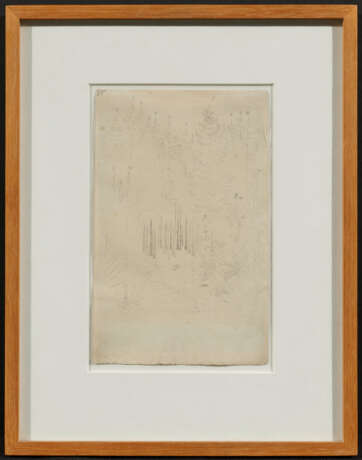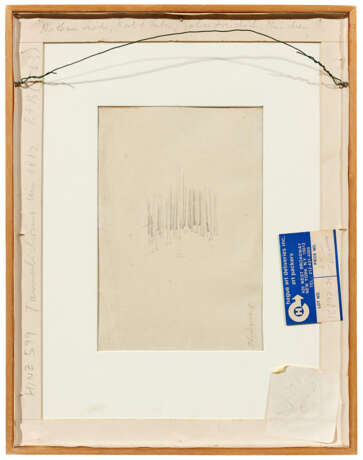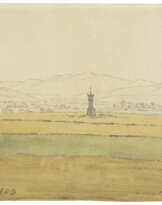ID 1302403
Lot 19 | Caspar David Friedrich. Waldstudie
Valeur estimée
€ 40 000 – 60 000
Title: Waldstudie.
Date: Ca. 1811.
Technique: Pencil on paper.
Mounting: Mounted.
Measurement: 19 x 12cm.
Notation: Signed verso: "Friedrich f".
Frame: Framed.
Verso:
Pencil sketch with spruce trunks and signature.
In her catalogue raisonné on Friedrich's drawings, Grummt states that she did not know the location of the sheet when she researched it. Like Kühl in 1928, she dates it to around 1811 and sees it as a preliminary study for, among other things, the oil painting 'Frühschnee' in the possession of the Hamburger Kunsthalle (listed no. 363 in Helmut Börsch-Supan and Karl Wilhelm Jähnig's cat. rais. of the oil paintings).
The conspicuous numbers above the tree tops are to be read as 'distance numbers', which define the ratio of the distances between the trees. They thus helped the artist to choose the correct colour tone when creating the painting (cf. Grummt, vol. I, p. 490)
Provenance:
- Gallery Kühl, Dresden 1928
- Collection Hirschland, New York 1966
- Private collection, New York 1974
- Gallery Heiner Friedrich, Munich ca. 1970
- Collection Kasper König, Berlin
Exhibitions:
- "Caspar David Friedrich der Graphiker. Handzeichnungen und Radierungen." Art exhibition Heinrich Kühl, Dresden 1928, no. 89.
- Gallery Thomas Fischer, Berlin 2018
Literature:
- Ch. Grummt: Caspar David Friedrich. Die Zeichnungen - das gesamte Werk, vol. II., Munich 2011, p. 633, no. 655 with ill.
Here with information on exhibitions, provenance and the note "location unknown" and further literature:
- S. Hinz: Caspar David Friedrich als Zeichner. Ein Beitrag zur stilistischen Entwicklung der Zeichnungen und ihrer Bedeutungen für die Datierung der Gemälde, Diss., Greifswald 1966, p. 69, comment 1, cat. rais. no. 599;
- M. Bernhard: Deutsche Romantik - Handzeichnungen, Munich 1974, ill. p. 563;
- W. Busch: Trennendes und Verbindendes in der Zeichnungsauffassung von Caspar David Friedrich und Julius Schnorr von Carolsfeld. In: Jahrbuch der Dresdener Kunstsammlungen
29, 2001 (2004), p. 105
The most important Romantic painter: an initiator of modernism
Within Kasper König's collection, which is so modern and contemporary in character, two small, non-colored works on paper by one artist appear to be visually and historically divergent. And yet the inclusion of Caspar David Friedrich in the collector's interest is extremely logical. The innovations of the most influential painter of German Romanticism sometimes disturbed his conservative contemporaries to such an extent that Johann Wolfgang von Goethe was so angry in a letter to Sulpitz Boisserée: "Friedrich's paintings can just as well be seen upside down" (translated). Today, Caspar David Friedrich is celebrated precisely for the historically radical new attitude of his artistic work. His painting " Der Mönch am Meer" (1808, Nationalgalerie Berlin), is not only regarded by art historian Werner Busch as "the epitome of a modern picture". Robert Rosenblum sees Friedrich as the starting point of abstract art and Florian Illies establishes the link between Friedrich's art and modernism in a wide variety of genres, including conceptual art. Currently, in the year of his 250th birthday, numerous exhibitions are dedicated to the artist.
Insight into the working methods of a genius
A drawing by Caspar David Friedrich, which has found its way into Kasper König's collection, illustrates the painter's working process. The sheet from 1811 is related to the oil painting " Der Chasseur im Walde" (The Chasseur in the Forest) from 1814. The front of the " Waldstudie" (Forest Study) sheet shows the layout of the snow-covered spruce forest in the painting, but without the figure of the French soldier. The place where the man will stand is marked with an "a". The raven, which caws at the lone man in the painting, is also not shown here. Numbers next to the individual treetops mark the distance to the viewer's position, with the highest numbers assigned to the nearest trees. The same numbers therefore indicate the same distances and thus also similar color values. The drawing on the reverse is a reduction to the central, but here bare, spruce trunks, which are depicted in varying degrees of hatching and internal drawing and which appear quite abstract in their arrangement. The letter "a" for the location of the chasseur is again indicated. This page also bears the signature. And without context? A highly modern sheet. Can we dare to isolate these drawings from their context and view them purely aesthetically? If so, the abstract arrangement of the stems and the auxiliary figures give the sheet a strong modernity. They are reminiscent of notations or even - a bold association - of Andy Warhol's "Do It Yourself" paintings, which play with the popular "paint by numbers" motifs
| Artiste: | Caspar David Friedrich (1774 - 1840) |
|---|---|
| Technique appliquée: | Crayon |
| Catégorie maison de vente aux enchères: | Aquarelles, Dessins et Pastels |
| Artiste: | Caspar David Friedrich (1774 - 1840) |
|---|---|
| Technique appliquée: | Crayon |
| Catégorie maison de vente aux enchères: | Aquarelles, Dessins et Pastels |
| Adresse de l'enchère |
VAN HAM Kunstauktionen GmbH Hitzelerstr. 2 50968 Köln Allemagne | ||||||||||||||
|---|---|---|---|---|---|---|---|---|---|---|---|---|---|---|---|
| Aperçu |
| ||||||||||||||
| Téléphone | +49 221 92586215 | ||||||||||||||
| Fax | +49 221 92 58 62 4 | ||||||||||||||
| Commission | 32% | ||||||||||||||
| Conditions d'utilisation | Conditions d'utilisation | ||||||||||||||
| Heures d'ouverture | Heures d'ouverture
|
Plus du Créateur
Termes connexes
- Caspar David Friedrich (1774 - 1840)
- Crayon
- 18./19. C.
- 18./19. Jh.
- Allemagne
- Caspar David Friedrich
- Copenhagen School
- Dessin
- Deutschland
- Dresden School
- Dresdener Schule
- Forêt
- Handzeichnungen
- Kopenhagener Schule
- Paysage
- Rahmen
- Romanticism
- Romantik
- Watercolour / Drawings
- framed
- Aquarelles, Dessins et Pastels








